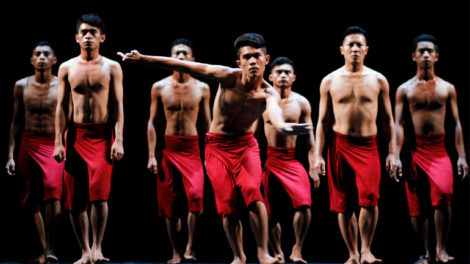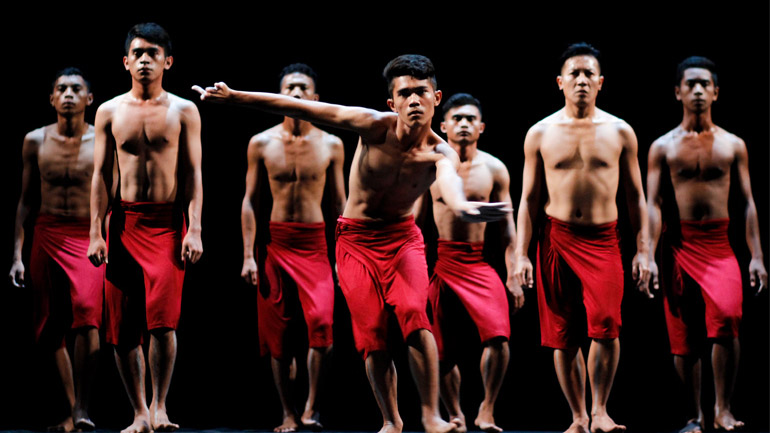8 January 2017, Carriageworks, Eveleigh (Sydney). Sydney Festival 2017
Cry Jailolo and Balabala, both choreographed by Eko Supriyanto, were both danced by men and women from Jailolo, a remote town on the western side of the island of Halmahera in the Maluku Islands (formerly known as the Moluccas).
Cry Jailolo, made for seven men, was perhaps the more theatrical of the two works. Not being familiar with the traditional dances of this part of Indonesia I have no idea if the work reflects those traditions, although publicity material states that Cry Jailolo is based on a local dance called ‘Legu Salai’. But whatever its origins the work is a mesmerising 50 minutes or so of changing rhythms, patterns and spatial concerns. It begins with one dancer, barefooted as are all the men, stamping out a rhythm with the sole of one foot and the heel of another. It continues for what seems like a long time but it establishes the overall repetition that characterises the work.
This single dancer is then joined by the rest of the men, who move in a close-knit group around the performing space changing direction every so often when one of the group claps his hands and takes over the leadership. In this section the dancers resemble a school of fish travelling through the water—and indeed Jailolo is a coastal town well-known as a diving centre and for its spectacular sea life.
But soon the story seems to shift to the land and a cyclone appears to hit the town. The men dance individually and in a frenzied manner, twirling and twisting as they manage the conditions. One dancer in particular (the shortest of the dancers seen in the back row of the featured image) was so involved with the wild choreography that he seemed to be in a trance. It was absorbing dancing from an audience point of view too, and it was impossible not to admire the powerful focus the dancers had and the choreographer’s exceptional ability to create patterns and relationships between the dancers.
Cry Jailolo ended as it had begun with a single dancer left on the stage to dance until the lights had completely faded.
Balabala was made on five women, also from Jailolo. It too is said to be grounded in the performing traditions of the region—this time in two dances usually performed by men. But with the choreographer trained in both the Indonesian martial art of Pencak Silat and classical Javanese dance, references to both were clear. The dancers arm movements and powerful thrusts of the body referenced (for me anyway) Pencak Silat. On the other hand, one dancer in particular often stepped forward in Javanese/Balinese fashion with heel first and toes turned up, and yet another, with her arms moving as if holding a fan and body slightly bent to one side, reminded me of moments in the Balinese Legong.
But Balabala was about giving a voice to women and it was powerfully performed and, again, with a strong sense of focus.
Indonesia is an archipelago of great cultural and ethnic diversity. It is most common for Westerners to see dance from the western islands, especially Java and Bali and, to a lesser extent, Sumatra. It was an exceptional pleasure to see material, albeit created in a contemporary vocabulary, from an area further to the east, and also to be made aware of the different ethnicity of people from that region.
Michelle Potter, 12 January 2017
Featured image: Scene from Cry Jailolo, Ekos Dance Company Indonesia


Lovely review thank you Michelle. it made the two major dances come alive.
God bless
Linette Pilkington-Bone